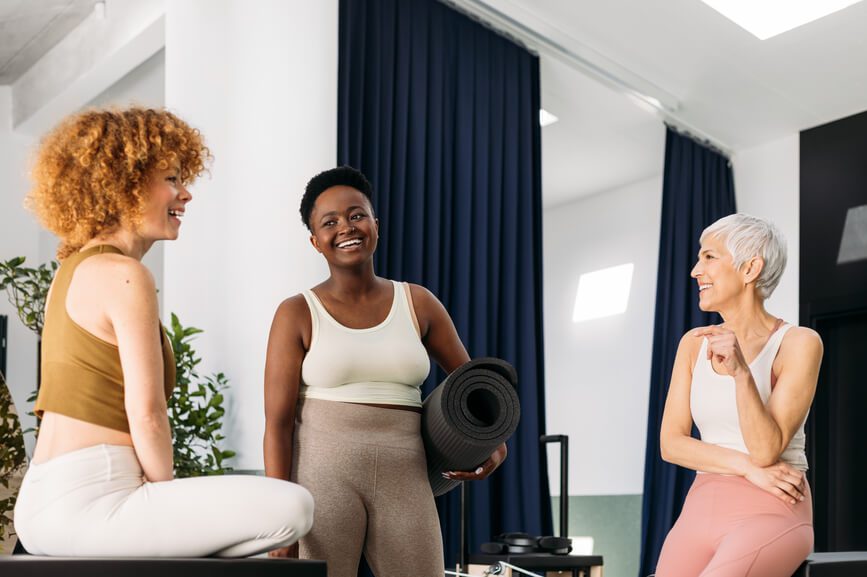How to set yearlong fitness goals

There is a fundamental problem with New Year’s resolutions: People often don’t keep them for more than a few months at the most. This may not be a huge deal if your resolution was to plan a mini adventure or to really work on your tennis backhand. But if your resolution was fitness related (as many resolutions are), well — you should try to keep that one. Fitness and health and intertwined, and without health, what do you have, really?
There are various reasons people fail to keep their fitness resolutions, but key causes include boredom, a lack of motivation and the lack of a plan or structure. If you’re trying to go from little or no exercise to doing it for a full year, it’s overwhelming without a plan.
That’s why, below, we have a general approach to setting fitness goals, along with a month-by-month workout plan for you, made in conjunction with two trainers from our favorite fitness app, Aaptiv. (Reminder: Eligible Haven Term policyholders enjoy a no-cost subscription through our Haven Life Plus bonus rider.)
General approach
“You can increase motivation by mixing up your workout routine,” says Aaptiv trainer and running expert Raj Hathiramani. To keep yourself engaged, he suggests “varying your workouts within each month and possibly each week. This could range from running solo outside and strength training at home to doing a virtual bike ride and attending a yoga or pilates class.”
To keep yourself on track, apps like Aaptiv can provide audio coaching and specific workouts for additional accountability and motivation, he says. It’s like virtual personal training to help you in achieving your goals.
He also mentions another approach: “Instead of doing a different workout routine each month, consider setting monthly themes about behaviors you want to change. This can span several aspects of your well-being such as fitness, mental health, nutrition, recovery, and sleep. Ask yourself ‘What would make me happier?’ since the more your life reflects your values, the happier you’ll be. In addition, make your monthly goals SMART — specific, measurable, attainable, relevant, time-based.”
Be serious about it, but don’t be too hard on yourself, at least when you start out setting goals: “Your age and current fitness level, weekly routine, experience, injuries or conditions, and life schedule are all factors to consider when deciding what your monthly goals should be,” he says.
“Progress is never a straight line up, so incorporate step-back or recovery weeks and acknowledge there will be factors out of your control affecting your routine.”
Month by month
To follow Hathiramani’s ideas you’ll need to do some planning and thinking. Or if you’d rather skip that, and just jump into something that’ll work, just try this month-by-month plan:
January
“January can be a month for a lot of indoor body weight type of things, maybe building up towards your plank, increasing the amount of push ups you can do,” says Aaptiv trainer and former college volleyball player Casey Sines.
There are two good reasons to do bodyweight exercises in January. One: It’s cold, and these are activities you can do indoors at home. Two: This kind of exercise, though worthwhile, can become repetitive, so start it during the month when you’re still full of can-do, will-do, must-keep-my-resolutions spirit.
February
“February should be something kind of fun,” in order to avoid burnout, says Sines, who recommends dance cardio. “Aaptiv has fun dance cardio routines that you can just listen to and follow along with,” she says, who also mentions Zumba classes as an indoor but not at-home option. (Note: at-home dance cardio can also be a fun family activity/great way of helping the kids burn energy indoors without breaking stuff).
March
You’re still indoors, and Sines recommends going to strength training: “Pilates is a great indoor one, whether you’re going to a studio or doing an Aaptiv class — we have a ton of different options for mat pilates you can just do at home,” she says.
April
“Okay, spring month, try picking up a sport that maybe you haven’t looked into before, like pickleball or even dodgeball” says Sines. “I’ve seen this in my clients: They start playing a sport more and suddenly they start moving more in general because they want to do better.”
Sines also notes that, depending on where you live, April could still be chilly, in which case there are plenty of indoor sports to choose from.
May and June
If you’re enjoying the sport you started in April, that should keep you going through May. (And if you’re not loving it, May is a great time to try a different one, since it will be warm enough for whatever sports you might enjoy.)
As for June, “try challenging your endurance,” says Sines. “Whether you are choosing to walk or to run or to get out on your bike, let June be all about how to build your stamina.”
July and August
“Yoga to me feels very ‘Happy Summertime,’” says Sines. And of course you can do it outside while working on your tan.
Also, after spending April, May and June doing a lot of cardio and endurance, it’s good to do something gentler for a month. If you have kids, July and August are difficult months to keep to a fitness routine, but it’s easy to commit to regular yoga via Aaptiv, which is always available when you are.
September
“I think boxing is a great bridge between sport and athletic work,” says Sines. “I’ve also found a lot of people that really like boxing and, when they’re doing it, don’t feel like they’re at the gym working out. And you can do things at home too, like shadowboxing so you don’t have to be in a gym in a class with a trainer.”
Depending on the weather, boxing and shadowboxing are also good indoor / outdoor activities.
October
You’re going back indoors, but that doesn’t mean you have to go back to what you did last winter. Try the treadmill. “It doesn’t have to be power walking for 45 minutes – that sounds horrible even to me,” says Sines.
If you change the angle of the treadmill (either at home or during a gym workout) the experience becomes more dynamic. “You can do three intense minutes at one incline, then the incline goes up and then for four minutes it’s pushing your power walk and then it’s two fast minutes at a different angle,” says Sines.
November
After a month of cardio on the treadmill, “try one month that is specifically about strength training,” says Sines. “So in November you’re doing really heavy weights for you with smaller reps, and it’s all about focusing on your strength, not so much on your cardio.” These can be upper body workouts (to help upper body strength, naturally), or routines focused on muscle groups in your legs, back or elsewhere.
December
If there is one month when you should burn calories, it’s December: post Thanksgiving, and right at the time of end-of-year feasting and drinking. “It’s a month when you could combine cycling, rowing, elliptical, stair climber,” or whatever other devices you have access to either at home or at the gym, says Sines, which will keep things entertaining.
Do that around the holidays, and you’ll experience one of the many benefits of exercise: Next January’s fitness goals will seem a whole lot easier.




